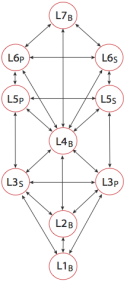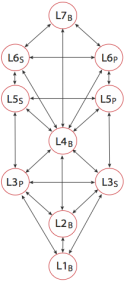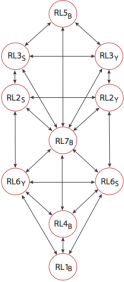Instincts & Emergent Frameworks
Significance of Psychosocial Pressures
The first class of emergent frameworks (as distinct from taxonomic frameworks) was identified in relation to the forced reversal of oscillating dualities in .
Additional classes may be discovered in due course. If, like the first class, they are inherently dynamic, then they will all present as Trees.
Those emergent frameworks produced an issue of classification. The taxonomic hierarchy within which all the constituent elements belonged was the . As a result, they are named «emergent root hierarchies».
Here is an example taken from that section:
| PH2 | Original PH2 Tree |
New Element | Emergent RH Tree |
Root-L on Reversal |
|
|---|---|---|---|---|---|
| L7 |

|
→ | L4 in PH5 |

|
RL5-Communication |
| L6 | → | L4 in PH3 | RL3-Change | ||
| L5 | → | L4 in PH2 | RL2-Inquiry | ||
| L4 | → | L4 in PH7 | RL7-Willingness | ||
| L3 | → | L4 in PH6 | RL6-Purpose | ||
| L2 | → | L4 in PH4 | RL4-Experience | ||
| L1 | → | L4 in PH1 | RL1-Action | ||
However, the new elements need to be identified by their , and so the graphic is misleading. It should show that: K-L7 = , K-L6P = , K-L6S = , etc. See the improved diagram below showing the effect of forced reversal in ).
| RH | Standard RH Tree |
New Element on Forced Reversal | Emergent RH Tree |
Tree Level |
|
|---|---|---|---|---|---|
| L7 |

|
L4 in PH5, so in RL5-Communic'n |

|
K-L7 | |
| L6 | L4 in PH3, so in RL3-Change |
K-L6 | |||
| L5 | L4 in PH2, so in RL2-Inquiry |
K-L5 | |||
| L4 | L4 in PH7, so in RL7-Willingness |
K-L4 | |||
| L3 | L4 in PH6, so in RL6-Purpose |
K-L3 | |||
| L2 | L4 in PH4, so in RL4-Experience |
K-L2 | |||
| L1 | L4 in PH1, so in RL1-Action |
K-L1 |
It can be conjectured that the Tree levels in the Emergent Hierarchies would have the identical instinctual properties to those in the . This is shown in the next table.
| RL | Standard RH Tree |
Standard Psychosocial Pressure | Emergent RH Tree |
Predicted Psychosocial Pressure |
|---|---|---|---|---|
| 7 |

|
Selflessness via |

|
Selflessness via
PH5-Communication element |
| 6 | Autonomy via |
Autonomy via
PH3-Change element |
||
| 5 | Understanding via | Understanding via RL2-Inquiry element |
||
| 4 | Well-being via |
Well-being via
RL7-Willingness element |
||
| 3 | Acceptability via |
Acceptability via
RL6-Purpose element |
||
| 2 | Certainty via |
Certainty via
RL4-Experience element |
||
| 1 | Performance via |
Performance via
RL1-Action element |
Test of the Conjecture
Inspecting the frameworks developed there, suggests that this conjecture is correct. Several of the Centres formulated without the benefit of these investigation fit perfectly:
- L3 Centres are labeled "" and for effective promotion the purposes must be selected to be acceptable whether it relates to yourself () or to others (). If it is not, then the divergent realities cannot be reconciled.
- L5 Centres are labeled "" and the psychosocial pressure is understanding. It is evident that proper understanding is required for any persuasive explanation.
- L6 Centres are labeled "" and you cannot enable anything properly without autonomy in relation to your self () or in the situation ().
One was less obvious but now appears straightforward:
- L1 Centre is labeled "" and the phrase only vaguely suggested the importance of time. However, now that this pressure has been changed to performance, the link becomes more obvious.
However, given that the above confirms the conjecture, there are three Centres whose labeling requires correction.
- L2 Centre was labeled "". However, this says little or nothing about the pressure for certainty, and all elements of experience will inevitably be "used". The phrase has therefore been altered to: "", which indicates the confidence that comes from feeling certain.
- L4 Centre was labeled "". But this seems too general. It is re-labeled "" so tying it into well-being, which is necessary for sustaining any special effort.
- L7 Centre was labeled "" which now seems too general. The phrase has therefore been provisionally altered to: "", which indicates a submission and so selflessness, and provides distinctiveness from other communications.
- Now pop-up the provisional full generic picture relating to the forced duality reversal.
Initially posted: 4-Aug-2013. Amended 16-June-2014.
All material here is in a draft form. There will be errors and omissions. Nothing should be copied or distributed without express permission. Thank you.Copyright © Warren Kinston 2009-2018. All Rights Reserved.